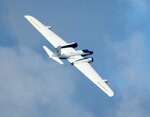Campaign seeks to understand reflective particles in the stratosphere, which cooling schemes would enhance
14 FEB 2023
BY PAUL VOOSEN

Instruments aboard a modified WB-57F bomber will count and analyze natural particles at altitudes of 20 kilometers, over 12 miles or 63,000 feet. ROBERT MARKOWITZ/NASA-JSC
Any work on solar geoengineering—the notion of artificially making the atmosphere more reflective to cool an overheated planet—is fraught with controversy. Last year, for example, a tech entrepreneur claimed he launched two weather balloons from Baja California into the stratosphere, where they may have released a puff of sulfur dioxide that gave rise to a small patch of reflective sulfate particles. The stunt drew widespread condemnation. But for researchers, it prompted a question: If a rogue actor had conducted a larger release, would they be able to detect it—or know with any certainty what it would do?
The U.S. National Oceanic and Atmospheric Administration (NOAA) is venturing into the fray to answer these questions, with a bid to understand the types, amounts, and behavior of particles naturally present in the stratosphere. Unlike the Mexico caper, the balloons and high-altitude aircraft in the program aren’t releasing any particles or gases. But the large-scale field campaign is the first the U.S. government has ever conducted related to solar geoengineering. It’s very basic research, says Karen Rosenlof, an atmospheric scientist at NOAA’s Chemical Sciences Laboratory. “You have to know what’s there first before you can start messing with that.”
Research on solar geoengineering—also called solar radiation management—has long been anathema to some climate scientists and activists. They fear it could distract from emissions cuts, could have unforeseen risks, and would not address some impacts of rising carbon dioxide, including ocean acidification. Federal agencies have largely steered clear of the work, even after a report from the National Academies of Sciences, Engineering, and Medicine (NASEM) in 2021 recommended a $200 million research program.
Congress directly ordered NOAA to develop a program in a 2020 spending bill. Support for the program, innocuously dubbed Earth’s Radiation Budget, has grown to nearly $10 million annually. SilverLining, an organization supportive of solar geoengineering research, lobbied for it, and gained the support of key legislators, says Kelly Wanser, SilverLining’s executive director, who came to climate advocacy from a career in technology. She says she told the lawmakers that emissions cuts weren’t happening fast enough, and that solar geoengineering might—or might not—be needed to reduce impacts in the next 40 years. “What do we need to know to evaluate those things in a very rigorous and honest-with-ourselves way?” Wanser asks. “I want to know.”
One focus of the NOAA program is sulfates, the reflective particles that would be lofted into the stratosphere in many solar geoengineering proposals. Volcanoes and industrial emissions are the main natural sources of sulfur dioxide, one precursor of sulfates; carbonyl sulfide, a gas emitted by microbes in the oceans, is another. The updrafts in severe storms in the tropics are thought to pump the gases into the stratosphere, but massive forest fires are emerging as another important mechanism for lifting them.
Because of a temperature inversion at the stratosphere's base, sulfate particles linger there for years, which encourages geoengineering advocates. But researchers need a clearer picture of natural stratospheric particles before they can contemplate supplementing them artificially, says Gregory Frost, the NOAA atmospheric chemist who oversees the program.
In 2020, NOAA began regularly launching sensor-equipped weather balloons to gather baseline data on the size and concentration of the particles. The record should allow NOAA to detect shifts in particle distributions, which could indicate a new source, such as an eruption—or a clandestine geoengineering intervention, Frost says.
The measurements could also help climate modelers represent stratospheric particles more realistically. “The only way to know if our models are doing the right thing is to have data to evaluate them,” says Simone Tilmes, a modeler at the National Center for Atmospheric Research (NCAR). At the moment, most models handle particles in a coarse way, categorizing them into a few arbitrary size ranges. With NOAA funding, Tilmes’s team has now upgraded NCAR’s flagship climate model with 40 possible bins for sulfate size, and so far it seems to more reliably capture events like the sulfur-rich eruption of Mount Pinatubo in 1991.
Now, the project is launching its next phase, the largest stratospheric aircraft campaign in the past 2 decades, “if not ever,” Frost says. One of NASA’s WB-57 research jets—a heavily modified bomber from the 1960s—has been outfitted with 17 instruments, many of which have never flown to the stratosphere before. One can measure sulfur dioxide levels down to 2 parts per trillion, and another can distinguish different particles by their chemical makeup.
Next week, flights will begin out of Houston, Texas, to altitudes of up to 20 kilometers, and later this month, the team plans to move to Fairbanks, Alaska, where they will fly until late March. At that time of the year, air that entered the stratosphere a half-decade earlier in the tropics descends in the Arctic. “We’re going to get into really old stratospheric air,” says Troy Thornberry, the NOAA atmospheric chemist who leads the flights. By studying aging sulfate particles, the team hopes to witness the chemical reactions that break them apart and release sulfur at the end of their lifetimes. They want to study how such sulfur interacts with organic particles such as soot and the dust of meteorites. Rosenlof says they will also study how soot absorbs the Sun’s heat, causing air parcels to rise and prolonging particle lifetimes in the stratosphere.
Additional flights are planned for Costa Rica in 2024 and the Southern Hemisphere in 2025. But in the meantime, the team is open to missions of opportunity. If a massive volcanic eruption occurs, they’ve assembled the perfect payload to explore its impact, Frost says. “That would be an event we’d want to study if at all possible.” The same goes for any wildfires similar in scale to those in Australia in 2020.
Some researchers want the U.S. government to put together a bigger solar geoengineering research program. Although the NOAA program is well designed, it’s a small piece of the puzzle, says Chris Field, a climate scientist at Stanford University and chair of the NASEM report. “It’s really important to find a way to ask bold questions about where something unexpected could go wrong.” In March 2022, Congress ordered the White House’s Office of Science and Technology Policy to develop such a plan, but it still has not been released. “Federally funded research is a very good idea—and the only way this work ideally should be funded,” says Sikina Jinnah, who studies geoengineering governance at the University of California, Santa Cruz.
Although some climate scientists disagree that such research should go forward or have even called for a ban on it, shutting it down would be a mistake, says James Hurrell, a climate scientist at Colorado State University who previously led NCAR. “If we could help avoid the worst impacts [of climate change] and buy more time for the world to reduce concentrations, don’t we want to know that?” And if it’s a bad idea, he adds, “the best way to prove that is through research.”
Correction, 15 February, 12:45 p.m: A previous version of the story incorrectly stated that the stratosphere has no weather.
See: https://www.science.org/content/art...ontent=alert&et_rid=255259432&et_cid=4598348&
It is interesting when weapons of war, like the WB-57 the former Martin B-57 Canberra, is repurposed for peaceful intentions. Because of the high altitudes plumbed by this aircraft, the two crew members who are positioned at separate tandem stations in the forward section of the fuselage wear full pressure suits like those worn in the U-2 and the SR-71, the latter being the survivors of the experimental fighter aircraft, the YF-12A, designed and constructed by Kelly Johnson at Lockheed's secret Skunk Works. The pilot station contains all the essential equipment for flying the aircraft while the sensor equipment operator (SEO) station contains both navigational equipment and controls for the operation of the payloads that are located throughout the aircraft. The WB-57 can fly for approximately 6.5 hours, has a range of approximately 2500 miles, and can carry up to 8,800 lbs of scientific payload.
Hartmann352

NASA - NOAA

NASA - NOAA
14 FEB 2023
BY PAUL VOOSEN

Instruments aboard a modified WB-57F bomber will count and analyze natural particles at altitudes of 20 kilometers, over 12 miles or 63,000 feet. ROBERT MARKOWITZ/NASA-JSC
Any work on solar geoengineering—the notion of artificially making the atmosphere more reflective to cool an overheated planet—is fraught with controversy. Last year, for example, a tech entrepreneur claimed he launched two weather balloons from Baja California into the stratosphere, where they may have released a puff of sulfur dioxide that gave rise to a small patch of reflective sulfate particles. The stunt drew widespread condemnation. But for researchers, it prompted a question: If a rogue actor had conducted a larger release, would they be able to detect it—or know with any certainty what it would do?
The U.S. National Oceanic and Atmospheric Administration (NOAA) is venturing into the fray to answer these questions, with a bid to understand the types, amounts, and behavior of particles naturally present in the stratosphere. Unlike the Mexico caper, the balloons and high-altitude aircraft in the program aren’t releasing any particles or gases. But the large-scale field campaign is the first the U.S. government has ever conducted related to solar geoengineering. It’s very basic research, says Karen Rosenlof, an atmospheric scientist at NOAA’s Chemical Sciences Laboratory. “You have to know what’s there first before you can start messing with that.”
Research on solar geoengineering—also called solar radiation management—has long been anathema to some climate scientists and activists. They fear it could distract from emissions cuts, could have unforeseen risks, and would not address some impacts of rising carbon dioxide, including ocean acidification. Federal agencies have largely steered clear of the work, even after a report from the National Academies of Sciences, Engineering, and Medicine (NASEM) in 2021 recommended a $200 million research program.
Congress directly ordered NOAA to develop a program in a 2020 spending bill. Support for the program, innocuously dubbed Earth’s Radiation Budget, has grown to nearly $10 million annually. SilverLining, an organization supportive of solar geoengineering research, lobbied for it, and gained the support of key legislators, says Kelly Wanser, SilverLining’s executive director, who came to climate advocacy from a career in technology. She says she told the lawmakers that emissions cuts weren’t happening fast enough, and that solar geoengineering might—or might not—be needed to reduce impacts in the next 40 years. “What do we need to know to evaluate those things in a very rigorous and honest-with-ourselves way?” Wanser asks. “I want to know.”
One focus of the NOAA program is sulfates, the reflective particles that would be lofted into the stratosphere in many solar geoengineering proposals. Volcanoes and industrial emissions are the main natural sources of sulfur dioxide, one precursor of sulfates; carbonyl sulfide, a gas emitted by microbes in the oceans, is another. The updrafts in severe storms in the tropics are thought to pump the gases into the stratosphere, but massive forest fires are emerging as another important mechanism for lifting them.
Because of a temperature inversion at the stratosphere's base, sulfate particles linger there for years, which encourages geoengineering advocates. But researchers need a clearer picture of natural stratospheric particles before they can contemplate supplementing them artificially, says Gregory Frost, the NOAA atmospheric chemist who oversees the program.
In 2020, NOAA began regularly launching sensor-equipped weather balloons to gather baseline data on the size and concentration of the particles. The record should allow NOAA to detect shifts in particle distributions, which could indicate a new source, such as an eruption—or a clandestine geoengineering intervention, Frost says.
The measurements could also help climate modelers represent stratospheric particles more realistically. “The only way to know if our models are doing the right thing is to have data to evaluate them,” says Simone Tilmes, a modeler at the National Center for Atmospheric Research (NCAR). At the moment, most models handle particles in a coarse way, categorizing them into a few arbitrary size ranges. With NOAA funding, Tilmes’s team has now upgraded NCAR’s flagship climate model with 40 possible bins for sulfate size, and so far it seems to more reliably capture events like the sulfur-rich eruption of Mount Pinatubo in 1991.
Now, the project is launching its next phase, the largest stratospheric aircraft campaign in the past 2 decades, “if not ever,” Frost says. One of NASA’s WB-57 research jets—a heavily modified bomber from the 1960s—has been outfitted with 17 instruments, many of which have never flown to the stratosphere before. One can measure sulfur dioxide levels down to 2 parts per trillion, and another can distinguish different particles by their chemical makeup.
Next week, flights will begin out of Houston, Texas, to altitudes of up to 20 kilometers, and later this month, the team plans to move to Fairbanks, Alaska, where they will fly until late March. At that time of the year, air that entered the stratosphere a half-decade earlier in the tropics descends in the Arctic. “We’re going to get into really old stratospheric air,” says Troy Thornberry, the NOAA atmospheric chemist who leads the flights. By studying aging sulfate particles, the team hopes to witness the chemical reactions that break them apart and release sulfur at the end of their lifetimes. They want to study how such sulfur interacts with organic particles such as soot and the dust of meteorites. Rosenlof says they will also study how soot absorbs the Sun’s heat, causing air parcels to rise and prolonging particle lifetimes in the stratosphere.
Additional flights are planned for Costa Rica in 2024 and the Southern Hemisphere in 2025. But in the meantime, the team is open to missions of opportunity. If a massive volcanic eruption occurs, they’ve assembled the perfect payload to explore its impact, Frost says. “That would be an event we’d want to study if at all possible.” The same goes for any wildfires similar in scale to those in Australia in 2020.
Some researchers want the U.S. government to put together a bigger solar geoengineering research program. Although the NOAA program is well designed, it’s a small piece of the puzzle, says Chris Field, a climate scientist at Stanford University and chair of the NASEM report. “It’s really important to find a way to ask bold questions about where something unexpected could go wrong.” In March 2022, Congress ordered the White House’s Office of Science and Technology Policy to develop such a plan, but it still has not been released. “Federally funded research is a very good idea—and the only way this work ideally should be funded,” says Sikina Jinnah, who studies geoengineering governance at the University of California, Santa Cruz.
Although some climate scientists disagree that such research should go forward or have even called for a ban on it, shutting it down would be a mistake, says James Hurrell, a climate scientist at Colorado State University who previously led NCAR. “If we could help avoid the worst impacts [of climate change] and buy more time for the world to reduce concentrations, don’t we want to know that?” And if it’s a bad idea, he adds, “the best way to prove that is through research.”
Correction, 15 February, 12:45 p.m: A previous version of the story incorrectly stated that the stratosphere has no weather.
See: https://www.science.org/content/art...ontent=alert&et_rid=255259432&et_cid=4598348&
It is interesting when weapons of war, like the WB-57 the former Martin B-57 Canberra, is repurposed for peaceful intentions. Because of the high altitudes plumbed by this aircraft, the two crew members who are positioned at separate tandem stations in the forward section of the fuselage wear full pressure suits like those worn in the U-2 and the SR-71, the latter being the survivors of the experimental fighter aircraft, the YF-12A, designed and constructed by Kelly Johnson at Lockheed's secret Skunk Works. The pilot station contains all the essential equipment for flying the aircraft while the sensor equipment operator (SEO) station contains both navigational equipment and controls for the operation of the payloads that are located throughout the aircraft. The WB-57 can fly for approximately 6.5 hours, has a range of approximately 2500 miles, and can carry up to 8,800 lbs of scientific payload.
Hartmann352

NASA - NOAA
NASA - NOAA
Last edited:




 Figure 1
Figure 1 